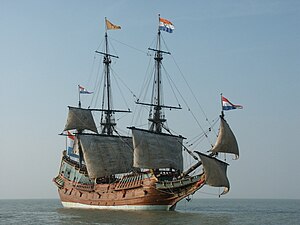 Full-scale replica of the Batavia
| |
| History | |
|---|---|
| Namesake | Batavia, Dutch East Indies |
| Owner | Dutch East India Company (VOC) |
| Completed | 1628 |
| Maiden voyage | 29 October 1628 |
| Fate | Wrecked in Wallabi Group, Houtman Abrolhos, 4 June 1629 |
| General characteristics | |
| Class and type | East Indiaman |
| Tonnage | 600 tons[1] |
| Length | 45.3 meters (149 feet)[2] |
| Beam | 10.19 meters (33.4 feet)[2] |
| Depth of hold | 5.45 meters (17.9 feet)[2] |
| Sail plan | Full-rigged[3] |
| Complement | 341 passengers and crew |
| Speed | 5 knots (9.3 km/h; 5.8 mph)[citation needed] |
| Armament | at least 22 cast-iron cannon, 6 bronze, 2 composite |
Batavia (Dutch pronunciation: [baːˈtaːvijaː] ) was a ship of the Dutch East India Company (VOC). She was built in Amsterdam in 1628 as the flagship of one of the three annual fleets of company ships[4] and sailed that year on her maiden voyage for Batavia, capital of the Dutch East Indies. On 4 June 1629, Batavia was wrecked on the Houtman Abrolhos, a chain of small islands off Western Australia.
As the ship broke apart, approximately 300 of the Batavia's 341 passengers and crew made their way ashore, the rest drowning in their attempts. Her commander, Francisco Pelsaert, sailed to Batavia to get help, leaving in charge senior VOC official Jeronimus Cornelisz, unaware he had been plotting a mutiny prior to the wreck. Cornelisz tricked about twenty men under soldier Wiebbe Hayes into searching for fresh water on nearby islands, leaving them to die. With the help of other mutineers, he then orchestrated a massacre that, over the course of several weeks, resulted in the murder of approximately 125 of the remaining survivors, including women, children and infants; a small number of women were kept as sex slaves.[5]
Meanwhile, Hayes' group had unexpectedly found fresh water and, after learning of the atrocities, waged battles with Cornelisz's group. In October 1629, at the height of their last and deadliest battle, they were interrupted by the return of Pelsaert aboard the rescue vessel Sardam. Pelsaert subsequently tried and convicted Cornelisz and six of his men, who became the first Europeans to be legally executed in Australia. Two other mutineers, convicted of comparatively minor crimes, were marooned on mainland Australia, thus becoming the first Europeans to permanently inhabit the Australian continent, although nothing more was heard of them. Only 122 of the original passengers made it to the port of Batavia.
Associated today with "one of the worst horror stories in maritime history", Batavia has been the subject of numerous published histories. Due to its unique place in the history of European contact with Australia, the story of Batavia is sometimes offered as an alternative founding narrative to the landing of the First Fleet in Sydney. Of the forty-seven or so VOC wrecks which have been located and identified, Batavia is the only early 17th century example from which the remaining hull components have been retrieved, conserved and subject to detailed study.[6] Many Batavia artifacts are housed at the Western Australian Shipwrecks Museum in Fremantle, while a replica of the ship is moored as a museum ship in Lelystad in the Netherlands.
- ^ Van Duivenvoorde 2015, pp. 18, 142.
- ^ a b c Van Duivenvoorde 2015, p. 404.
- ^ Van Duivenvoorde 2015, p. 144.
- ^ Van Duivenvoorde 2015, p. 18.
- ^ Batavia (1629): giving voice to the voiceless – Symposium (PDF) (booklet). Nedlands: University of Western Australia. 7 October 2017. Archived (PDF) from the original on 20 March 2018. Retrieved 14 March 2020.
- ^ Van Duivenvoorde 2015, p. 423.